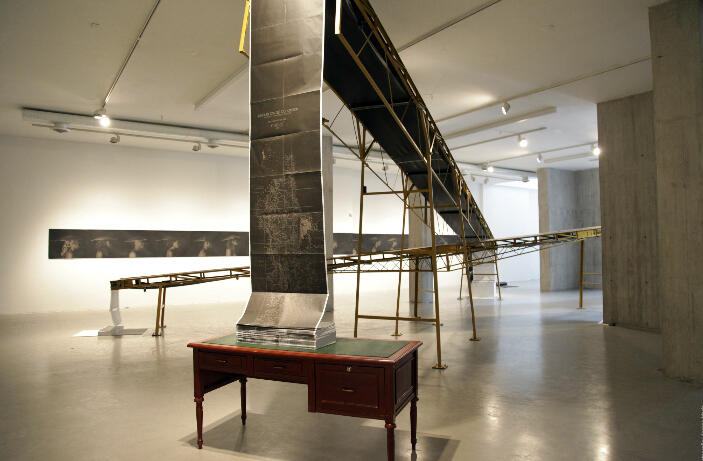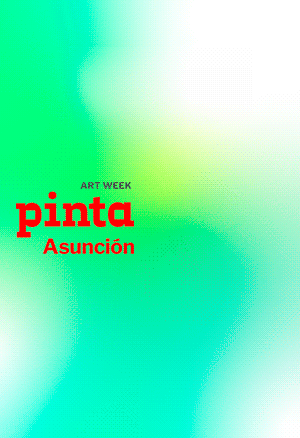Eduard Moreno
NC Arte, Bogotá
The conquest of the land through opencast mining seems to be the point of departure for the reflections that Eduard Moreno’s current exhibition at NC Arte, curated by Conrado Uribe, propose.

These reflections are based on mining in Colombia, which falls into the eschatological category which society has reached in its search for the non-existent promises of this economic activity over the course of history.
The first image the viewer encounters when entering the exhibition is a great conveyor belt on which a continuous carbon paper form moves from one extreme to the other, pushing and popping as in an eternal balance. This form conveys images either of maps or faces of characters that appear to be people devoted to mining, all of them black race genotypes, like the carbon paper that transports them. It would be a light observation if one bears in mind that those races were brought to these lands for the very purpose of exploiting them, except for the fact that what is revealed is that what is actually transported through those belts is humanity and its own territory. The fate of this race, which was initially subjugation, will be its own destruction, thanks to the false promises of concepts of morality, of political power, or of civilizing projects, accompanied by a crisis of the sacred [which] reduce their lives to simply economic achievements, as the artist points out when he refers to this exhibit, as if his eternally tragic destiny was merely to go from one side of the belt on which they are transported to the other.
Analyzing in further depth the reason for the artifact being in the middle of the room, invading it with its mere presence, one perceives the first broken promise of that modernity that Moreno pretends to show. It is clear that mining was a fundamental pillar of modern processes and perhaps the symbol of the development of any nation, particularly of First-World societies, with their promises of abundance and happiness, while paradoxically what it represents for our people is poverty, displacement, and violence. And his reflection goes even further when he wonders about the raison d’être of that standard and finds its genesis in the loss of values ranging from religion, which provides them ethic codes, to territorial uprooting, and it is there that I place the second image in the tour of this exhibition.
Two canvases featuring the development of a cap with a visor, embroidered with images suggesting the baroque period, introduce the viewer to the following space showcasing the same caps already assembled and pretending to be the dwelling place of bug colonies. There the insects “cover” themselves with the fabrics embroidered in red and gold (a reference to our colonial legacy) and underneath these fabrics they carry out an eschatological activity characteristic of their feeding habits, in a clear metaphor for all of our human behaviors…to such an extent that they will end up eating their own sky – the cap – composed of the most exquisite baroque embroideries, just like in an eschatology of the objective destruction of our culture or of [our] nature, as stated by the Spanish philosopher Félix Duque, whom the artist quotes.
The exhibition closes with a video divided into two parts, which shows the screening of the landing on the Moon in 1969 in the upper part and the processes of opencast mining in the lower part. A logical development if it is contrasted with the pieces featuring the bugs and the caps: it is man plundering his land in order to clear his sky; where everything that happens is the classical burst of glory, but on the part of man, making his cultural concepts of the sacred vanish ipso facto, in a metaphor in which man is situated in the eschatological dance of his own nature.





